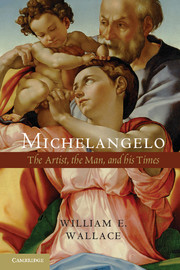Book contents
- Frontmatter
- Contents
- Preface
- Note to the Reader
- Michelangelo - The Artist, the Man and His Times
- PART I
- PART II
- 9 ROME, 1534–1542
- 10 ROME, 1542–1545
- 11 PAPAL ARCHITECT, ROME, 1546–1549
- 12 NEW FRIENDS, DIMINISHING FAMILY
- 13 ST. PETER'S
- 14 LATE WORK, LONG LIFE
- 15 FINAL YEARS
- 16 RETURN TO FLORENCE
- Notes
- Cast of Principal Characters
- Popes During Michelangelo's Life
- Abbreviations of Frequently Cited Works
- Index
- Plate section
12 - NEW FRIENDS, DIMINISHING FAMILY
Published online by Cambridge University Press: 05 June 2012
- Frontmatter
- Contents
- Preface
- Note to the Reader
- Michelangelo - The Artist, the Man and His Times
- PART I
- PART II
- 9 ROME, 1534–1542
- 10 ROME, 1542–1545
- 11 PAPAL ARCHITECT, ROME, 1546–1549
- 12 NEW FRIENDS, DIMINISHING FAMILY
- 13 ST. PETER'S
- 14 LATE WORK, LONG LIFE
- 15 FINAL YEARS
- 16 RETURN TO FLORENCE
- Notes
- Cast of Principal Characters
- Popes During Michelangelo's Life
- Abbreviations of Frequently Cited Works
- Index
- Plate section
Summary
The 1540s appeared to be a decade of promise for Michelangelo: the Julius tomb was finally brought to completion; the artist was working for an enlightened patron; he had a tight-knit circle of extremely close friends; he had money to invest in land and business ventures, and his nephew had initiated the search for a suitable bride. Michelangelo was a flourishing poet; he was lauded by his contemporaries and if not for Del Riccio's death would have gone to press with a selection of his poems. He enjoyed the patronage of princes, the protection of the pontiff (Paul III), and the attentions of the rich and powerful. He had succeeded in “raising up” his family. He had reason to be content, but before the end of the decade events conspired to spoil these happy circumstances.
In 1546, death claimed Luigi del Riccio, a loss to Michelangelo compounded in the following year by the deaths of Vittoria Colonna, Sebastiano del Piombo, and Pietro Bembo, as well as King Francis I, a potential patron and the artist's final hope for the liberation of Florence. Michelangelo was seventy-two years of age when he wrote: “I am old, and death has robbed me of the thoughts of youth.” But things got worse. Later in 1547, he lost a major source of his income when the Po ferry benefice was taken from him (fortunately, only temporarily), and then his great-nephew died, the youngest child of Francesca and Michele Guicciardini, causing Michelangelo to grieve “as if it had been my own son.”
- Type
- Chapter
- Information
- MichelangeloThe Artist, the Man and his Times, pp. 248 - 268Publisher: Cambridge University PressPrint publication year: 2009

